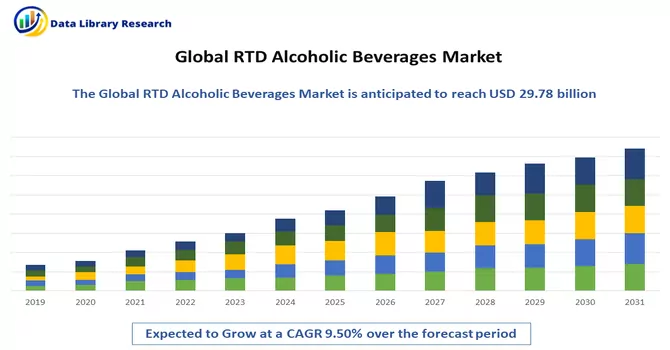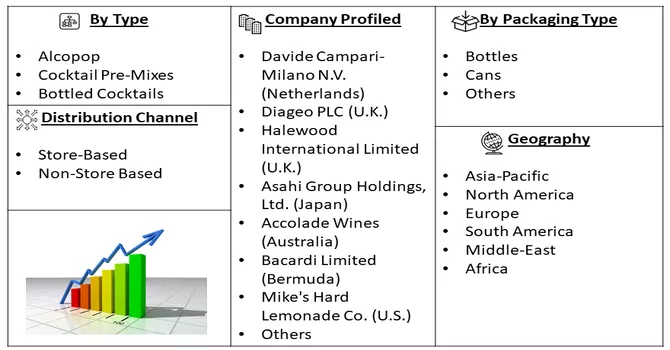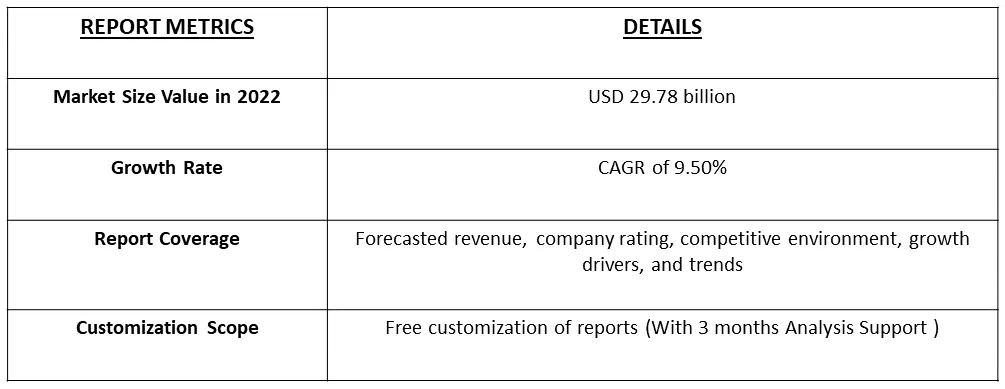The ready-to-drink (RTD) alcoholic beverages market was valued at USD 29.78 billion in 2022 and is expected to register a CAGR of 9.50% during the forecast period, 2023-2030.

Get Complete Analysis Of The Report - Download Free Sample PDF
The ready-to-drinks (RTDs) category has undergone several critical shifts in response to the changing dynamic of global consumer drinking preferences and habits. Despite significant criticism the large strides made in the demand for and marketing of beverage alcohol products have earned a respectable place in the RTDs category. The demand momentum hasn't lost much luster as a result of the high level of convenience provided to consumers, who have been instrumental in fuelling the popularity of easy-to-make alcoholic beverages.
RTD alcoholic beverages are ready-to-drink beverages that contain a certain amount of alcohol. Different types of RTD alcoholic beverages are available in the market and are served for different purposes. They are sold in prepared form and are ready for consumption.
Consumers are showing interest in RTD beverages with global or ethnic flavors. This trend has led to a wider variety of options, including beverages inspired by Latin American, Asian, and Mediterranean flavors. RTD brands are partnering with other companies or influencers to create unique, limited-edition products. These collaborations generate excitement and appeal to a specific target audience.
Segmentation:
The Global Ready to Drink (RTD) Alcoholic Beverages Market is Segmented
By Type :
Packaging Type :
Distribution Channel :
Flavours :
Geography :
The market sizes and forecasts are provided in terms of value (USD million) for all the above segments.

For Detailed Market Segmentation - Download Free Sample PDF
Drivers:
The growing popularity of low-spirit beverages among the population especially among millennials
The growing popularity of low-alcohol and low-spirit beverages reflects a broader shift in consumer behavior toward healthier, more balanced, and more socially conscious choices. This trend has prompted the alcohol industry to adapt and offer a wider range of products to cater to evolving consumer preferences. Low-alcohol beverages come in a wide range of flavors and styles, appealing to millennials who appreciate variety and unique taste experiences. From hard seltzers to low-alcohol cocktails, there are diverse options available. Thus, the market is expected to witness significant growth over the forecast period.
Innovation in marketing strategies and product endorsements.
The global market for ready-to-drink alcoholic beverages is experiencing significant growth due to several factors. These include changes in customer lifestyles, rising demand for premixed drinks from the youth demographic, the increasing popularity of new and ethnic flavors, and innovative marketing and promotional strategies. Other key drivers of growth are the expansion of e-commerce, competitive pricing, enhanced accessibility, and the introduction of cocktails featuring natural and health-enhancing ingredients within these beverages. Additionally, the market is benefiting from increased investments in pubs and bars and the wide array of flavors offered in ready-to-drink alcoholic beverages, further fueling its global expansion.
Restraints :
The growth of the market faces certain obstacles, including religious or cultural norms prevalent in various countries, significant taxation and duties on alcoholic products, and the adverse health consequences associated with alcohol consumption. Additionally, stringent regulations governing the advertising of alcoholic items and the proliferation of anti-alcohol campaigns are exerting a detrimental influence on the expansion of the high-strength premixes market. COVID-19 Impact on the Studied Market.
The alcohol industry, including RTD segments, faced unique challenges due to the pandemic. These included changes in consumer behavior, reduced on-premises consumption, and shifts in the competitive landscape. The pandemic accelerated the growth of e-commerce for alcoholic beverages, including RTD options. Consumers increasingly turned to online platforms to purchase RTD alcohol and have it delivered to their homes, avoiding in-person shopping. The pandemic led to a surge in the popularity of canned and bottled RTD alcoholic beverages, including hard seltzers and cocktails. These formats are portable, shelf-stable, and well-suited for consumption at home or in outdoor settings, which resonated with pandemic-related restrictions and preferences. Thus, the market is expected to witness significant growth over the forecast period.
Segmental Analysis:
The bottled cocktails segment is expected to witness significant growth over the forecast period.
Bottled cocktails are pre-mixed alcoholic beverages that are commercially prepared, bottled, and ready for consumption without the need for additional mixing or bartending skills. These pre-mixed cocktails offer the convenience of enjoying a bar-quality drink at home, at a social gathering, or in various other settings. One of the advantages of bottled cocktails is the consistency of taste. Since they are produced in controlled environments, the flavor profile remains the same from bottle to bottle, ensuring a reliable taste experience. Thus, the segment is expected to witness significant growth over the forecast period.
The flavored segment is expected to witness significant growth over the forecast period.
Flavored RTD alcohol beverages have become increasingly popular due to their accessibility, variety, and ability to cater to evolving consumer preferences. They offer a convenient and enjoyable way to savor distinctive flavors and enjoy alcoholic beverages without the need for extensive bartending knowledge.
Canned segment is expected to witness significant growth over the forecast period.
Canned RTD alcohol beverages come in a wide variety of options, including cocktails, spirits, wine, hard seltzers, and flavored malt beverages. They can feature classic cocktail flavors like margaritas, piña coladas, and mojitos, as well as unique and trendy offerings like hard seltzers and canned cocktails with innovative flavor combinations. The canned format makes these beverages highly portable. They are easy to carry to picnics, outdoor events, the beach, or any location where glass bottles or elaborate bar setups may be impractical. Thus, the segment is expected to witness significant growth over the forecast period.
North America is Expected to Witness Significant growth Over the Forecast Period.
North America has seen a dynamic and evolving market for RTD alcohol beverages, with a wide range of options and flavors that cater to changing consumer preferences and lifestyles. The convenience, portability, and variety of RTD options have contributed to their popularity in the region. North America, including the United States and Canada, has witnessed substantial growth in the RTD alcohol market. This growth is driven by changing consumer preferences, particularly among younger generations, who appreciate the convenience and variety offered by RTD options. Millennials and Generation Z consumers have been at the forefront of the RTD alcohol trend in North America. They value convenience, portability, and the diverse flavor options available in RTD beverages. These generations have driven demand for hard seltzers, canned cocktails, and flavored malt beverages. Thus, the market is expected to witness significant growth over the forecast period.

Get Complete Analysis Of The Report - Download Free Sample PDF
The ready-to-drink (RTD) alcoholic beverages market competitive landscape provides details by competitor. Some of the major players operating in the ready-to-drink (RTD) alcoholic beverages Market are:
Key Players :
Key Developments:
1) In April 2023: The Coca-Cola Company is eyeing up the opportunity in the alcoholic ready-to-drink (RTD) market, as part of its overarching strategy.
2) In May 2023: Sapporo in partnership with IBM Japan launched its first alcoholic beverage produced by AI. The system will generate 100 possible formulations for the product in a matter of seconds, drawing on a database of 1,200 formulations and 700 ingredients tested by Sapporo in the past.
Q1. What is the current RTD Alcoholic Beverages Market size?
The ready-to-drink (RTD) alcoholic beverages market is currently valued at USD 29.78 billion.
Q2. At what CAGR is the market projected to grow within the forecast period?
RTD Alcoholic Beverages Market is expected to register a CAGR of 9.50% during the forecast period.
Q3. What segments are covered in the RTD Alcoholic Beverages Market Report?
By Type, By Packaging Type, By Distribution Channel, By Flavours and Geography are the segments covered covered in the RTD Alcoholic Beverages Market Report.
Q4. Which region has the largest share of the RTD Alcoholic Beverages Market? What are the largest region's market size and growth rate?
North America has the largest share of the market . For detailed insights on the largest region's market size and growth rate request a sample here
Data Library Research are conducted by industry experts who offer insight on industry structure, market segmentations technology assessment and competitive landscape (CL), and penetration, as well as on emerging trends. Their analysis is based on primary interviews (~ 80%) and secondary research (~ 20%) as well as years of professional expertise in their respective industries. Adding to this, by analysing historical trends and current market positions, our analysts predict where the market will be headed for the next five years. Furthermore, the varying trends of segment & categories geographically presented are also studied and the estimated based on the primary & secondary research.
In this particular report from the supply side Data Library Research has conducted primary surveys (interviews) with the key level executives (VP, CEO’s, Marketing Director, Business Development Manager and SOFT) of the companies that active & prominent as well as the midsized organization
FIGURE 1: DLR RESEARH PROCESS

Extensive primary research was conducted to gain a deeper insight of the market and industry performance. The analysis is based on both primary and secondary research as well as years of professional expertise in the respective industries.
In addition to analysing current and historical trends, our analysts predict where the market is headed over the next five years.
It varies by segment for these categories geographically presented in the list of market tables. Speaking about this particular report we have conducted primary surveys (interviews) with the key level executives (VP, CEO’s, Marketing Director, Business Development Manager and many more) of the major players active in the market.
Secondary ResearchSecondary research was mainly used to collect and identify information useful for the extensive, technical, market-oriented, and Friend’s study of the Global Extra Neutral Alcohol. It was also used to obtain key information about major players, market classification and segmentation according to the industry trends, geographical markets, and developments related to the market and technology perspectives. For this study, analysts have gathered information from various credible sources, such as annual reports, sec filings, journals, white papers, SOFT presentations, and company web sites.
Market Size EstimationBoth, top-down and bottom-up approaches were used to estimate and validate the size of the Global market and to estimate the size of various other dependent submarkets in the overall Extra Neutral Alcohol. The key players in the market were identified through secondary research and their market contributions in the respective geographies were determined through primary and secondary research.
Forecast Model
